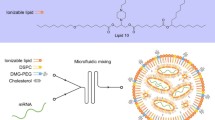Abstract
Cationic oligopeptides, including the amphipathic α-helical peptides, are applied to the targeted delivery of DNA to eukaryotic cells due to their DNA-compacting properties and the ability to destabilize the cell lipid bilayer in some cases. We synthesized the peptides differing in the number and location of residues of decanoic acid covalently attached to Lys residues in order to combine the DNA-binding and the membrane activities in a single molecule. We chose peptide structures that assisted in the formation of α helices. The DNA-binding ability of the peptides and the membrane activity of their complexes with DNA were shown to depend on the structure. The study of erythrocyte hemolysis by complexes with DNA of the pCMV LacZ plasmid and the peculiarities of transfection of these complexes revealed a correlation between the hemolytic activity and the expression level of the lacZ gene in cells.
Similar content being viewed by others
Abbreviations
- Acm:
-
acetamidomethyl
- Ahx:
-
residue of ε-amino-caproic acid
- DIC:
-
diisopropylcarbodiimide
- TFA:
-
trifluoroacetic acid
- TFE:
-
trifluoroethanol.
REFERENCES
Gariepy, J. and Kawamura, K., Trends Biotechnol., 2001, vol. 19, pp. 21–28.
Singh, D., Kiarash, R., Kawamura, K., LaCasse, E.C., and Gariepy, J., Biochemistry, 1998, vol. 37, pp. 5798–5809.
Morris, M.C., Chaloin, L., Heitz, F., and Divita, G., Curr. Opin. Biotechnol., 2000, vol. 11, pp. 461–466.
Niidome, T., Anzai, Sh., Sonoda, J., Tokunaga, Y., Nakahara, M., Hatakeyama, T., and Ayoagi, H., J. Pept. Sci., 1999, vol. 5, pp. 298–305.
Singh, D., Bisland, S.K., Kawamura, K., and Gariepy, J., Bioconjug. Chem., 1999, vol. 10, pp. 745–754.
Duguid, J.G., Li, C., Shi, M., Logan, M.J., Alila, H., Rolland, A., Tomlinson, E., Sparrow, J.T., and Smith, L.C., Biophys. J., 1998, vol. 74, pp. 2802–2814.
Rittner, K., Benavente, A., Bombard-Sorlet, A., Heitz, F., Divita, G., Brasseur, R., and Jacobs, E., Mol. Ther., 2002, vol. 5, pp. 104–114.
Vaysse, L. and Arveiler, B., Biochem. Biophys. Acta, 2000, vol. 1474, pp. 244–250.
Sheldon, K., Liu, D., Ferguson, J., and Gariepy, J., Proc. Natl. Acad. Sci. USA, 1995, vol. 92, pp. 2056–2060.
Zelphati, O., Uyechi, L.S., Barron, L.G., and Szoca, F.C., Biochem. Biophys. Acta, 1998, vol. 1390, pp. 119–133.
Nir, Sh. and Nieva, J., Prog. Lipid Res., 2000, vol. 39, pp. 181–206.
Liu, L.-P., Li, Sh.-Ch., Goto, N.K., and Deber, Ch.M., Biopolymers, 1996, vol. 39, pp. 465–470.
Scott, E.S., Wiseman, J.W., Evans, M.J., and Colledge, W.H., J. Gene Med., 2001, vol. 3, pp. 125–134.
Niidome, T., Urakava, M., Takaji, K., Matsuo, Y., Ohmori, N., Wada, A., Hirayama, T., and Aoyagi, H., J. Pept. Res., 1999, vol. 54, pp. 361–367.
Deber, Ch.M. and Li, Sh.-Ch., Biopolymers, 1995, vol. 37, pp. 295–318.
Cornut, I., Buttner, K., Dasseux, J.-L., and Dufourcq, J., FEBS Lett., 1994, vol. 349, pp. 29–33.
Ohmori, N., Niidome, T., Hatakeyama, T., Mihara, H., and Aoyagi, H., J. Pept. Res., 1998, vol. 51, pp. 103–109.
Niidome, T., Wakamatsu, M., Wada, A., Hirayama, T., and Aoyagi, H., J. Pept. Sci., 2000, vol. 6, pp. 271–279.
Marqusee, S. and Baldwin, R.L., Proc. Natl. Acad. Sci. USA, 1987, vol. 84, pp. 8898–8902.
Gottschalk, S., Sparrow, J.T., Hauer, J., Mims, M.P., Leland, F.E., Woo, S.L.C., and Smith, L.C., Gene Therapy, 1996, vol. 3, pp. 448–457.
Huang, Ch.-Y., Uno, T., Murphy, J.E., Lee, S., Hamer, J.D., Escobedo, J.A., Cohen, F.E., Radhakrishnan, R., Dwarki, V., and Zuckermann, R.N., Chem. Biol., 1998, vol. 5, pp. 345–354.
Ohsaki, M., Okuda, T., Wada, A., Hirayama, T., Niidome, T., and Aoyagi, H., Bioconjug. Chem., 2002, vol. 13, pp. 510–517.
Maniatis, T., Fritsch, E.F., and Sambrook, J., Molecular Cloning: A Laboratory Manual, Cold Spring Harbor, NY: Cold Spring Harbor Lab., 1982. Translated under the title Molekulyarnoe klonirovanie, Moscow: Mir, 1984.
Author information
Authors and Affiliations
Corresponding author
Additional information
Translated from Bioorganicheskaya Khimiya, Vol. 31, No. 1, 2005, pp. 22–30.
Original Russian Text Copyright © 2005 by Guryanov, Vlasov, Lesina, Kiselev, Baranov, Avdeeva, Vorob’ev.
Rights and permissions
About this article
Cite this article
Guryanov, I.A., Vlasov, G.P., Lesina, E.A. et al. Cationic oligopeptides modified with lipophilic fragments: Use for DNA delivery to cells. Russ J Bioorg Chem 31, 18–26 (2005). https://doi.org/10.1007/s11171-005-0002-z
Received:
Revised:
Issue Date:
DOI: https://doi.org/10.1007/s11171-005-0002-z




